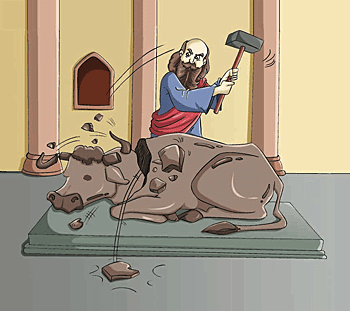icono-, icon-
(Greek: image, likeness; form of a person or object; a sacred, holy, or religious representaion)
2. A person who destroys sacred religious images.
3. A breaker or destroyer of images; especially, those set up for religious veneration.
4. A person who attacks cherished beliefs, traditional institutions, etc., as being based on error or superstition.

The original iconoclasts destroyed countless works of art; such as, religious images which were the subject of controversy among Christians of the Byzantine Empire, especially in the eighth and ninth centuries, when iconoclasm was at its height.
Those who opposed images did not simply destroy them, although many were demolished; they also attempted to have the images barred from display and veneration.
During the Protestant Reformation, images in churches were again felt to be idolatrous and were banned and destroyed. In the nineteenth century, the term "iconoclast" took on the secular sense that it has today; someone who breaks traditions, doctrines, convictions, practices, etc.
2. Someone who strongly opposes generally accepted beliefs and traditions.
2. Related to those who want to do away with religious images or who oppose their use in worship: "There are certain iconoclastically serious efforts by some people to get rid of any images of deities that that could be worshipped."
2. The description or illustration of any subject by means of drawings or figures; such as, any book or work in which this is done.
3. The branch of knowledge that deals with the representation of people or objects by any application of the arts of design.
4. A symbolic representation; especially, the conventional meanings attached to an image or images.
5. The study or analysis of subject matter and its meaning in the visual arts; iconology.
6. A representation or a group of representations of a person, place, or thing; such as, a portrait or a collection of portraits.
2. Subject matter in the visual arts; especially, with reference to the conventions regarding the treatment of a subject in artistic representation.
3. The study or analysis of subject matter and its meaning in the visual arts; iconology.
4. A representation or a group of representations of a person, place, or thing; such as, a portrait or a collection of portraits.
5. The art of representing or illustrating by means of pictures, images, or figures; a symbolic and metaphorical representation of a particular subject.
It is sometimes considered a component of cognitive archaeology, in which artistic representations which usually have an overt religious or ceremonial significance are studied.
Iconography is also the study of statues and images, bas-reliefs, busts, medals, etc. The earliest iconographical studies were published in the 16th century.
Extensive iconographical study did not begin in Europe until the 18th century; however, when, as a companion to archaeology, it consisted of the classification of subjects and motifs in ancient monuments.


